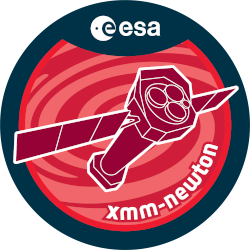

| Proposal ID | 076264 |
| Title | A huge ULX bubble in NGC 5585 |
| Download Data Associated to the proposal | https://nxsa.esac.esa.int/nxsa-sl/servlet/data-action-aio?obsno=0762640101 |
| DOI | https://doi.org/10.5270/esa-9v8zya2 |
| Principal Investigator, PI | Dr Roberto Soria |
| Abstract | Accreting black holes release their power through radiation and/or jets. We havediscovered an ultraluminous X-ray source (ULX) in the nearby galaxy NGC 5585,surrounded by a large (diameter ~300 pc) ionized nebula. We propose a joint XMM-Newton and HST study of this source. With XMM-Newton, we will determine theradiative power of the ULX, its spectral and time variability properties, andconstrain its mass. With HST, we will image the nebula, determine whether it isa jet-inflated ULX bubble, measure its kinetic power and source age, and searchfor an optical counterpart to the black hole. |
| Publications |
|
| Instrument | EMOS1, EMOS2, EPN, OM, RGS1, RGS2 |
| Temporal Coverage | 2015-06-19T22:50:42Z/2015-06-22T09:39:56Z |
| Version | 17.56_20190403_1200 |
| Mission Description | The European Space Agencys (ESA) X-ray Multi-Mirror Mission (XMM-Newton) was launched by an Ariane 504 on December 10th 1999. XMM-Newton is ESAs second cornerstone of the Horizon 2000 Science Programme. It carries 3 high throughput X-ray telescopes with an unprecedented effective area, and an optical monitor, the first flown on a X-ray observatory. The large collecting area and ability to make long uninterrupted exposures provide highly sensitive observations. Since Earths atmosphere blocks out all X-rays, only a telescope in space can detect and study celestial X-ray sources. The XMM-Newton mission is helping scientists to solve a number of cosmic mysteries, ranging from the enigmatic black holes to the origins of the Universe itself. Observing time on XMM-Newton is being made available to the scientific community, applying for observational periods on a competitive basis. |
| Creator Contact | https://www.cosmos.esa.int/web/xmm-newton/xmm-newton-helpdesk |
| Date Published | 2016-07-10T22:00:00Z |
| Last Update | 2025-08-04 |
| Keywords | "XMM", "source age", "XMM-Newton", "NGC 5585", "accreting blackhole release", "huge ulx bubble", "optical counterpart", "xmm newton", "pc ionized nebula", "kinetic power", "ngc 5585", "black hole", "time variability properties", "HST", "radiative power" |
| Publisher And Registrant | European Space Agency |
| Credit Guidelines | European Space Agency, Dr Roberto Soria, 2016, 'A huge ULX bubble in NGC 5585', 17.56_20190403_1200, European Space Agency, https://doi.org/10.5270/esa-9v8zya2 |